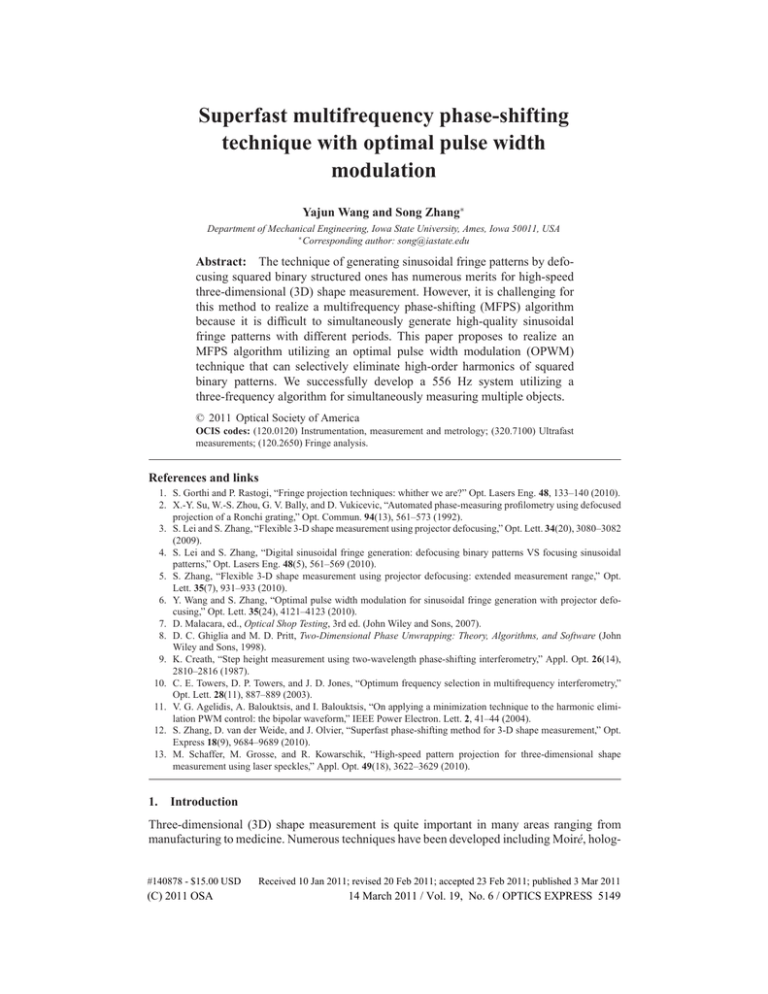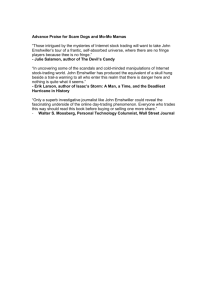Superfast multifrequency phase-shifting technique with optimal
advertisement

Superfast multifrequency phase-shifting
technique with optimal pulse width
modulation
Yajun Wang and Song Zhang∗
Department of Mechanical Engineering, Iowa State University, Ames, Iowa 50011, USA
∗ Corresponding author: song@iastate.edu
Abstract: The technique of generating sinusoidal fringe patterns by defocusing squared binary structured ones has numerous merits for high-speed
three-dimensional (3D) shape measurement. However, it is challenging for
this method to realize a multifrequency phase-shifting (MFPS) algorithm
because it is difficult to simultaneously generate high-quality sinusoidal
fringe patterns with different periods. This paper proposes to realize an
MFPS algorithm utilizing an optimal pulse width modulation (OPWM)
technique that can selectively eliminate high-order harmonics of squared
binary patterns. We successfully develop a 556 Hz system utilizing a
three-frequency algorithm for simultaneously measuring multiple objects.
© 2011 Optical Society of America
OCIS codes: (120.0120) Instrumentation, measurement and metrology; (320.7100) Ultrafast
measurements; (120.2650) Fringe analysis.
References and links
1. S. Gorthi and P. Rastogi, “Fringe projection techniques: whither we are?” Opt. Lasers Eng. 48, 133–140 (2010).
2. X.-Y. Su, W.-S. Zhou, G. V. Bally, and D. Vukicevic, “Automated phase-measuring profilometry using defocused
projection of a Ronchi grating,” Opt. Commun. 94(13), 561–573 (1992).
3. S. Lei and S. Zhang, “Flexible 3-D shape measurement using projector defocusing,” Opt. Lett. 34(20), 3080–3082
(2009).
4. S. Lei and S. Zhang, “Digital sinusoidal fringe generation: defocusing binary patterns VS focusing sinusoidal
patterns,” Opt. Lasers Eng. 48(5), 561–569 (2010).
5. S. Zhang, “Flexible 3-D shape measurement using projector defocusing: extended measurement range,” Opt.
Lett. 35(7), 931–933 (2010).
6. Y. Wang and S. Zhang, “Optimal pulse width modulation for sinusoidal fringe generation with projector defocusing,” Opt. Lett. 35(24), 4121–4123 (2010).
7. D. Malacara, ed., Optical Shop Testing, 3rd ed. (John Wiley and Sons, 2007).
8. D. C. Ghiglia and M. D. Pritt, Two-Dimensional Phase Unwrapping: Theory, Algorithms, and Software (John
Wiley and Sons, 1998).
9. K. Creath, “Step height measurement using two-wavelength phase-shifting interferometry,” Appl. Opt. 26(14),
2810–2816 (1987).
10. C. E. Towers, D. P. Towers, and J. D. Jones, “Optimum frequency selection in multifrequency interferometry,”
Opt. Lett. 28(11), 887–889 (2003).
11. V. G. Agelidis, A. Balouktsis, and I. Balouktsis, “On applying a minimization technique to the harmonic elimilation PWM control: the bipolar waveform,” IEEE Power Electron. Lett. 2, 41–44 (2004).
12. S. Zhang, D. van der Weide, and J. Olvier, “Superfast phase-shifting method for 3-D shape measurement,” Opt.
Express 18(9), 9684–9689 (2010).
13. M. Schaffer, M. Grosse, and R. Kowarschik, “High-speed pattern projection for three-dimensional shape
measurement using laser speckles,” Appl. Opt. 49(18), 3622–3629 (2010).
1.
Introduction
Three-dimensional (3D) shape measurement is quite important in many areas ranging from
manufacturing to medicine. Numerous techniques have been developed including Moiré, holog#140878 - $15.00 USD
(C) 2011 OSA
Received 10 Jan 2011; revised 20 Feb 2011; accepted 23 Feb 2011; published 3 Mar 2011
14 March 2011 / Vol. 19, No. 6 / OPTICS EXPRESS 5149
raphy, and fringe projection [1]. Among these methods, the digital fringe projection technique
has been exhaustively studied and widely used in many fields due to its simple setup, automatic
data processing, high-speed and high-resolution measurement capabilities.
For a digital fringe projection system, ideal sinusoidal fringe patterns are used to retrieve 3D
information. Su et al. [2] and Lei and Zhang [3] has proposed a technique that is to generate
sinusoidal fringe patterns by properly defocusing squared binary structured ones using a mechanical grating (former) or a digital video projector (latter), which we call a squared binary
method (SBM). The SBM has numerous advantages for 3D shape measurement especially for
high-speed applications [4]: (1) It is less sensitive to the synchronization between the camera
and the projector; (2) The nonlinear gamma of the projector does not affect the measurement
quality; (3) The exposure time can be much shorter than the projector’s single channel projection time for an off-the-shelf digital light processing (DLP) projector, thus it could enable a
superfast 3D shape measurement technique.
For the measurement of a single object without step heights, SBM can perform well if the
projector is properly defocused [4]. To extend the measurement range of the defocusing technique, Zhang proposed a method to obtain absolute phase by introducing binary coded patterns [5]. Because it permits point-by-point absolute phase extraction, the defocusing technique
is further enhanced and the high-speed multi-object measurement becomes possible. However,
this method is not trouble free. Because sinusoidal fringe patterns are generated by defocusing,
the binary coded ones are blurred, which makes it difficult to correctly determine the designed
code. As a result, the perfectly designed code might not work. This problem is deteriorated for
high-speed applications since motion could introduce additional misalignment.
To further improve the capability of high-speed multi-object measurement, this paper proposes a multifrequency phase-shifting (MFPS) method with an optimal pulse width modulation
(OPWM) technique. OPWM is a recently developed technique to improve the fringe quality for
the SBM [6]. The SBM performs well only when the fringe stripes are narrow but shows significant problems if the fringe stripes are wide. Moreover, an MFPS cannot be realized because
it is impossible to obtain high quality sinusoidal fringe patterns with different breadth under
the same defocusing degree. By selectively eliminate undesired harmonics, OPWM technique
permits the generation of high-quality fringes with different breadths under a slightly defocused projector. Therefore, the MFPS method, an effective and widely-adopted approach for
multi-object measurement, becomes feasible using the defocusing technique. Moreover, because OPWM still uses binary patterns, it maintains the aforementioned advantages of the
defocusing technique. In this research, we have developed a 5,000 Hz fringe projection system, that could realize 556 Hz 3D shape measurement using a three-frequency phase-shifting
method for simultaneous multiple objects measurement.
2.
2.1.
Principle
Three-step phase-shifting algorithm
Phase-shifting algorithms are widely used in optical metrology because of their measurement
speed and accuracy [7]. Numerous phase-shifting algorithms have been developed including
three step, four step, double three step, and five step. In this paper, we use a three-step phaseshifting algorithm with a phase shift of 2π /3. Three fringe images can be described as,
I1 (x, y) = I ′ (x, y) + I ′′ (x, y) cos(φ − 2π /3),
I2 (x, y) = I ′ (x, y) + I ′′ (x, y) cos(φ ),
(1)
(2)
= I ′ (x, y) + I ′′ (x, y) cos(φ + 2π /3).
(3)
I3 (x, y)
#140878 - $15.00 USD
(C) 2011 OSA
Received 10 Jan 2011; revised 20 Feb 2011; accepted 23 Feb 2011; published 3 Mar 2011
14 March 2011 / Vol. 19, No. 6 / OPTICS EXPRESS 5150
Where I ′ (x, y) is the average intensity, I ′′ (x, y) the intensity modulation, and φ (x, y) the phase to
be solved for. The phase,φ (x, y), and the texture, I ′ (x, y), can be solved for from these equations
h√
i
φ (x, y) = tan−1 3(I1 − I3 )/(2I2 − I1 − I3 ) ,
(4)
I ′ (x, y)
= (I1 + I2 + I3 )/3.
(5)
Equation (4) provides the phase ranging [−π , π ) with 2π discontinuities. This 2π phase jumps
can be removed to obtain the continuous phase map by adopting a phase unwrapping algorithm [8]. However, such a spatial phase unwrapping algorithm has limitations: it could not
used when large step height exists which may cause the phase change more than π , or multiple
objects need to be measured simultaneously.
2.2.
Multifrequency phase-shifting (MFPS) algorithm
As aforementioned, the phase we obtain from a single-frequency method is within the range of
[0, 2π ). When a fringe pattern contains more than one stripes, the phase need to be unwrapped
to obtain the continuous phase map. This means that if another set of wider fringe patterns (a
single fringe stripe can cover the whole image) is used to obtain a phase map without 2π discontinuities. The second phase map can be used unwrap the other one point by point without
spatial phase unwrapping. To obtain the phase of the wider fringe patterns, there are two approaches: (1) use very long wavelength directly; and (2) use two short wavelengths to generate
an equivalent long one. The former is not very commonly used because it is difficult to generate
high-quality wide fringe patterns due to noises or hardware limitations. Thus the latter is more
frequently adopted. This subsection will briefly explain the principle of this technique.
Theoretically, the relationship between the absolute phase Φ and the wavelength λ , and the
height h(x, y) can be written as
Φ = [C · h(x, y)/λ ] · 2π .
(6)
Here C is a system constant. Therefore, for λ1 < λ2 with absolute phase being Φ1 and Φ2 ,
respectively, their difference is
eq
] · 2π .
∆Φ12 = Φ1 − Φ2 = [C · h(x, y)/λ12
(7)
∆φ12 = [Φ1 − Φ2 ] (mod 2π ) = [φ1 − φ2 ] (mod 2π ).
(8)
eq
λ12
Here,
= λ1 λ2 /|λ2 − λ1 | is the equivalent wavelength between λ1 and λ2 . If λ2 ∈ (λ1 , 2λ1 ),
eq
> λ2 . In reality, we only have the wrapped phase, φ1 and φ2 . We know that the
we have λ12
relationship between the absolute phase is Φ and the wrapped phase φ = Φ (mod 2π ) with 2π
discontinuities. Here the modulus operator is to convert the phase to a range of [0, 2π ). Taking
the modulus operation on Eq.(7) will lead to
∆φ12 = ∆Φ12 (mod 2π ). If the wavelengths are properly chosen, so that the resultant equivalent
eq
eq
wavelength λ12
is large enough to cover the whole range of image (i.e., |C · h(x, y)/λ12
| < 1). In
this case, the modulus operator does not affect anything, thus no phase unwrapping is required.
However, because the existence of noises, two-frequency technique is usually not sufficient [9]. Practically, at least three frequency fringe patterns are required for point by point
absolute phase measurement. The multifrequency technique is designed so that the equivalent
widest fringe stripe can cover the whole image [10].
Assume another set of fringe patterns with wavelength (λ3 ) are used, the equivalent waveeq
length between λ1 and λ3 will be λ13
= λ1 λ3 /|λ3 − λ1 |. We will have
∆φ13
∆φ123
eq
= [φ1 − φ3 ] (mod 2π ) = {[C · h(x, y)/λ13
] · 2π } (mod 2π ),
eq
= (∆φ13 − ∆φ12 ) (mod 2π ) = {[C · h(x, y)/λ123
] · 2π } (mod 2π ).
#140878 - $15.00 USD
(C) 2011 OSA
(9)
(10)
Received 10 Jan 2011; revised 20 Feb 2011; accepted 23 Feb 2011; published 3 Mar 2011
14 March 2011 / Vol. 19, No. 6 / OPTICS EXPRESS 5151
eq
eq eq
eq
eq
eq
Here λ123
= λ12
− λ12
|. Now we only need |C · h(x, y)/λ123
| < 1 to ensure that the
λ13 /|λ13
absolute phase can be obtained without spatial phase unwrapping. Once the absolute phase of
the longest equivalent wavelength is obtained, it can reversely unwrap the phase of other wavelengths. The phase of shortest wavelength is usually used to recover 3D information because
the measurement accuracy is approximately inversely proportional to the wavelength.
2.3.
Optimal pulse width modulation (OPWM) technique
The aforementioned MFPS technique requires to generate sinusoidal fringe patterns with different frequencies. A conventional fringe projection system uses a computer to generate sinusoidal
fringe patterns that are sent to a projector. However, when 8-bit sinusoidal patterns are used,
there are many limitations due to the commercial projectors such as gamma calibration and
capturing speed [4]. The defocusing technique has the potential to alleviate these limitations.
However, the SBM performs well only when the fringe stripe is narrow. When the fringe
stripe becomes wide, it is difficult to obtain high-quality sinusoidal pattern by defocusing projector. This is because the binary square wave contains numerous harmonics. When the fringe
stripe is wide, the high-order harmonics are closer to the fundamental one, thus it is difficult
to drastically suppress them by the defocusing effect. However, to realize an MFPS algorithm,
sinusoidal patterns with wide fringe stripes are required. Moreover, under the same degree of
defocusing, it is practically impossible to generate high quality sinusoidal fringe patterns with
different wavelengths. Thus, a conventional SBM method cannot realize an MFPS algorithm.
/2
1
2
n!1
n
Fig. 1. Quarter-wave symmetric OPWM waveform.
To achieve high quality 3D shape measurement with wide fringe stripes, the OPWM technique was proposed [6]. This technique is to selectively eliminate undesired frequency components by inserting different types of notches in a conventional binary square wave. Then with
slightly projector defocusing, high-quality sinusoidal fringe patterns can be generated. Figure 1
illustrates a general quarter-wave symmetric OPWM pattern. The square wave is chopped n
times per-half cycle. For a periodic waveform with a period of 2π , because it is an odd function, only the sine terms are left with the coefficients being described as:
4 π /2
bk =
f (θ ) sin(kθ )d θ .
(11)
π θ =0
The n chops in the waveform provide n degrees of freedom to eliminate n − 1 selected harmonics whilst keeping the fundamental frequency component within a certain magnitude [11].
Due to the ability to eliminate undesired high-order harmonics, OPWM waveform could become sinusoidal after applying a small low-pass filter, which is similar to a small degree of
defocusing. Our previous research has shown that (1) the OPWM technique can be used to generate high-quality sinusoidal patterns even with very wide fringe stripes; and (2) it is not very
sensitive to the degree of defocusing. Here, the degree of defocusing corresponds to the depth
measurement range. The less sensitive to the degree of defocusing indicates that less phase error
is generated within the same depth range. In other words, under the same degree of defocusing,
it is possible for this technique to generate high-quality sinusoidal fringe patterns with different
periods. By this means, an MFPS method can be realized.
Z
#140878 - $15.00 USD
(C) 2011 OSA
Received 10 Jan 2011; revised 20 Feb 2011; accepted 23 Feb 2011; published 3 Mar 2011
14 March 2011 / Vol. 19, No. 6 / OPTICS EXPRESS 5152
3.
Experimental results
We have developed a superfast system that is composed of a DLP Discovery projection system,
a high-speed CMOS camera, and a self-developed synchronization circuit. The DLP Discovery
projection system includes a DLP Discovery board (D4000), an ALP High Speed and an optical
module (S3X). The camera used in this system is Phantom V9.1. The synchronization circuit
takes the projection timing signal and generate timing signal to trigger the camera.
(a)
(b)
(c)
(d)
(e)
(f)
(g)
(h)
(i)
(j)
Fig. 2. (a) Photograph of the captured scene; (b) One fringe pattern (λ1 = 60 pixels); (c)
One fringe pattern (λ2 = 90 pixels); (d) One fringe pattern(λ3 = 102 pixels); (e) Wrapped
phase φ1 ; (f) Wrapped phase φ2 ; (g) Wrapped phase φ3 ; (h) Equivalent phase difference
∆φ12 ; (i) Equivalent phase difference ∆φ13 ; (j) Resultant phase ∆φ123 .
To test the proposed algorithm, we chose three frequency fringe patterns with λ1 = 60, λ2 =
90, and λ3 = 102 pixels. It can be found that the resultant equivalent fringe wavelength is 765
pixels. In other words, if we use the projector to generate 765 pixel wide fringe patterns, no
spatial phase unwrapping is needed to recover absolute phase.
To demonstrate that this technique can be used to perform superfast 3D shape measurement
for multiple objects, we chose our system to switch and capture 2D fringe patterns at 5,000
Hz, and measured two separate objects. The camera image resolution is set as 576 × 576
pixels. In this experiment, there are two separate objects, a static sculpture on the right, and a
swinging pendulum ball on the left, as shown in Fig. 2(a). The diameter of the spherical ball is
about 17 mm, the stature is approximately 60 (H) × 45 (W) mm in the viewing volume of the
camera. Figure 2(b)-2(d) show the distorted OPWM fringe patterns with different frequencies.
Figures 2(e)-2(g) respectively show the wrapped phase maps extracted from those frequencies.
The corresponding equivalent wrapped phase for λ1 and λ2 is shown in Fig. 2(h), and that for
λ1 and λ3 is shown in Fig. 2(i). Finally, the phase map of the longest equivalent wavelength
can be obtained from these two equivalent phase maps, and the result is shown in Fig. 2(j). It
can be seen from this figure that this phase map has no 2π discontinuities, thus no spatial phase
unwrapping is needed.
#140878 - $15.00 USD
(C) 2011 OSA
Received 10 Jan 2011; revised 20 Feb 2011; accepted 23 Feb 2011; published 3 Mar 2011
14 March 2011 / Vol. 19, No. 6 / OPTICS EXPRESS 5153
From this longest equivalent wavelength phase map, the shortest one with λ1 = 60 pixels can
be unwrapped point by point that can then be used to recover 3D information. In this research,
we use the calibration technique introduced in Ref. [12] to calibrate our system. Because this
is an approximation method, the accuracy is not very high. We found that with the defocusing
technique, the measurement error is approximately root-mean-squared (rms) 0.19 mm over
a measurement depth range of 6.35 mm. We cannot implement any existing high-accuracy
structured light system calibration technique because they all require the projector to be in
focus, which is not the case for our system. We are exploring a new method to accurately
calibrate a defocused projector. If successful, it will significantly improve the measurement
accuracy of our system. At current stage, we believe our measurement accuracy is not as high
as other high-speed 3D shape measurement techniques such as the one described in Ref. [13].
Figure 3(a) shows the image after averaging three fringe patterns with the shortest wavelength. Fig. 3(b) shows the reconstructed 3D result. It can be seen that even though OPWM
technique can recover 3D shape very well, it shows some artifacts on the averaged texture image. This is because the operation of OPWM is in phase domain without considering the texture
information. It can be seen that the proposed method can be used to obtain absolute phase point
by point, and can be used to simultaneously measure multiple objects.
(a)
(b)
Fig. 3. (a) Averaged image of the object (Media 1); (b) 3-D result (Media 2).
Since the fringe images are captured at 5,000 Hz, and a three-frequency phase-shifting algorithm is used, the 3D shape measurement speed is actually 5,000/9 = 556 Hz, which is sufficient
to capture the rapid motion, such as a pendulum system. From 900 2D images, 100 3D frames
can be recovered. Media 1 shows the video of the averaged texture images, the video is played
at 25 fps, which is approximately 1/22 of the capturing speed. The textured images, I ′ (x, y)
in Eq. (5), are generated by averaging three shortest wavelength phase-shifted fringe patterns.
Media 2 shows the 3D reconstructed results at 25 fps. This experiment clearly demonstrated
that by combining the OPWM technique with the defocusing technique, a superfast MFPS
algorithm can be realized. This proposed technique can be used to measure multiple rapidly
moving objects simultaneously.
4.
Conclusion
This paper has presented a multifrequency phase-shifting method with an optimal pulse width
modulation technique to conduct superfast simultaneous multiple objects measurement. We
#140878 - $15.00 USD
(C) 2011 OSA
Received 10 Jan 2011; revised 20 Feb 2011; accepted 23 Feb 2011; published 3 Mar 2011
14 March 2011 / Vol. 19, No. 6 / OPTICS EXPRESS 5154
have developed a 556 Hz 3D shape measurement system using a three-frequency phase-shifting
algorithm. Experiments have been conducted and proved the success of the proposed technique.
#140878 - $15.00 USD
(C) 2011 OSA
Received 10 Jan 2011; revised 20 Feb 2011; accepted 23 Feb 2011; published 3 Mar 2011
14 March 2011 / Vol. 19, No. 6 / OPTICS EXPRESS 5155



